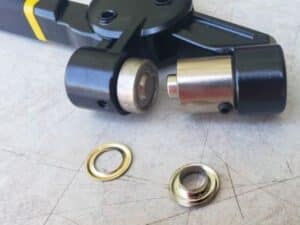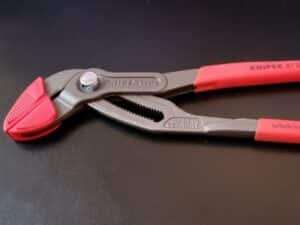Previously, I have shared how to securely attach bungee cord hooks with hog rings. But how do you splice or fasten together two pieces of bungee cord without using a bungee splicing kit or tying the ugly knots? In this article, I share how I use hog ring clamps and hog rings pliers to securely fasten together two separate pieces of shock cords. But first, why would you need to splice shock cords?
Reasons for splicing bungee cord
One of the reasons for joining together two bungee cord ends is to increase the strength of the elastic rope. Two bungee ropes tied together lengthwise are stronger than one. So, you can fasten together two thin pieces of bungee cords to achieve the desired strength.
Another reason for splicing shock cords is to increase the length. You can connect the ends of two short shock cords to make one long rope. This hack can be very helpful when repairing a broken shock cord in an emergency situation. For example, if the bungee strap on your kayak breaks while you are in the sea, you can just connect the two ends by splicing them together and wait until you get offshore to replace the entire rope.
Sometimes the intention may not be to splice two bungee cords but rather to make an eye loop for attaching a hook.
How to attach two bungee cords together
Whether you are making a loop on the end of a bungee cord or fastening two pieces together, you need to know how to make a very tight connection. With regular ropes, there are a million and one ways to make very tight knots. Unfortunately, nearly all those knots including sheet bend and bowline knots don’t work with shock cords. No sooner have you applied some serious tension on the elastic ropes than the knots come undone causing the rope to whip across your face. In fact, according to an article in Clean Med Journal, bungee cords are one of the leading causes of eye injury in camping, sailing, and cargo transportation activities.
Mostly, when the elastic shock cord snaps and strikes the eye, it can cause an eye injury that can sometimes be severe enough to cause loss of sight. Therefore, a better way to loop or secure two bungee cords together to minimize bungee injury is by using hog rings.
How to use hog rings to attach two bungee cords
Whether you are fixing a broken bungee strap on your boat, extending a short bungee rope to strap your cargo, or making a loop, here is how to do it with hog rings.
You will need:
- Hog ring fastener
- Hog ring pliers
- Bungee cords
Instructions
1. Prepare the hog ring and hog ring pliers
Pick the right size of hog ring and set it between the groove of the hog ring pliers. I prefer to use the spring-loaded hog ring pliers because they keep the hog ring from falling off.
The hog ring size should be the same as the sum of the diameters of the two shock cords. Also, be sure to use stainless steel hog rings so that water does not damage them.
If you live in a saltwater location, there is no other option but to use stainless steel clips. Anything else will corrode and cause the cord to break.
2. Prepare the shock cords you want to splice
Line up the two ends of the shock cords that you want to join together. Let the ends overlap by at least 6 inches.
If you are making a bungee loop, double-back the cord on one end to make an eye and hold it in place.
3. Crimp the hog rings onto the shock cords
Place the hog ring over the two overlapping bungee rope ends near one end (1 inch from the end) and crimp it into place with hog ring pliers. Then stretch the two cords slightly and attach more hog rings an inch or two apart.
If you want to attach the bungee cords lengthwise to increase tension, you will need to attach the hog ring clamps further from each other. At least 6 inches apart.
To secure a bungee loop, crimp 2 or 3 hog rings a few inches from the end. The distance should be at least twice the diameter of the rope.
Viola! That is how to splice shock cords together cleanly and tidily without using unreliable big knots that pull through so easily.
To secure the ends of the shock cords from fraying, you can burn lightly with a lighter and pinch off the hot end with your fingers to bind the fabric. Alternatively, you can apply some fabric stabilizer liquid to seal the ends.









